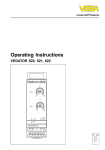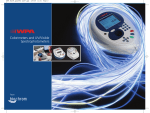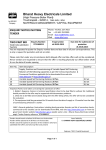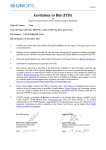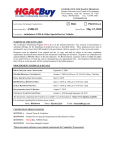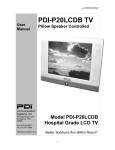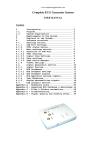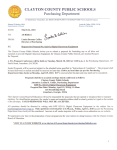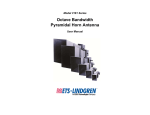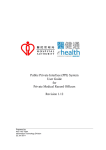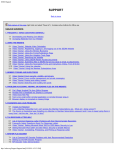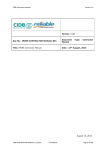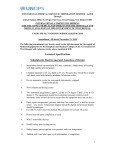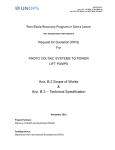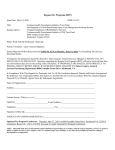Download Guideline - Preparation of specifications
Transcript
Technical specifications for goods This guideline is also posted on the UNOPS intranet: Main Page Practices Procurement ‘How to’ guides Organizational Effectiveness Centre 20 December 2006 Procurement Guideline: Technical specifications for goods Updated 20 December 2006 Contents 1 WHAT IS A SPECIFICATION ...................................................................................................................................... 2 2 HOW TO MAKE GOOD SPECIFICATIONS .............................................................................................................. 2 3 THE THREE TYPES OF SPECIFICATIONS.............................................................................................................. 3 4 WHEN TO REQUEST SAMPLES ................................................................................................................................. 4 5 WHEN TO USE DRAWINGS......................................................................................................................................... 4 6 HOW TO USE BRAND NAMES .................................................................................................................................... 5 7 REFERENCES TO SPECIFIC STANDARDS .............................................................................................................. 5 8 WHO SHOULD BE INVOLVED IN DEVELOPING SPECIFICATIONS................................................................ 5 9 THE PROCESS OF DEVELOPING SPECIFICATIONS ........................................................................................... 5 10 RANGE OF INFORMATION INCLUDED IN A SPECIFICATION....................................................................... 7 11 LIFE CYCLE COSTING............................................................................................................................................... 8 12 MISMANAGEMENT AND FRAUD RISKS ............................................................................................................... 8 13 TIPS ................................................................................................................................................................................. 8 14 EXAMPLES OF SPECIFICATIONS........................................................................................................................... 9 1 What is a specification In a purchasing context, a specification is a statement of needs. It defines what the purchaser wants to buy and, consequently, what the supplier is required to provide. Specifications can be simple or complex depending on the need. It is important that the specification be a true, complete and accurate statement of the buyer’s requirements, taking into account the product’s actual use in situ. The specifications must present a clear statement of the required standards of workmanship, materials, and performance of the goods and services to be procured. Apart from being a means of identifying the goods, a specification will eventually form part of any resulting contract. The specification forms part of the invitation to bid or request for quotation. Other elements in the tender document include the “Specific Conditions”, the “General Terms and Conditions”, etc. 2 How to make good specifications • State the requirement clearly, concisely and logically in functional and performance terms unless specific technical requirements are needed; • Include enough information for suppliers to identify what is required, and cost it accordingly; • Provide equal opportunity for all potential suppliers to offer goods which satisfies the needs of the user, including alternative solutions; • Do not over-specify requirements as this might limit the number of responses; 2 Procurement Guideline: Technical specifications for goods Updated 20 December 2006 • Do not include unnecessary features that might prevent some suppliers from offering • Whenever appropriate, consider whether life cycle costing should be used as evaluation method. • Care must be taken in drafting specifications to ensure that they are not restrictive. In the specification of standards for equipment, materials, and workmanship, recognized international standards should be used as much as possible. Where other particular standards are used, whether national standards or other standards, the specifications should state that equipment, materials, and workmanship that meet other authoritative standards, and which ensure at least a substantially equal quality as the standards mentioned, will also be acceptable. 3 The three types of specifications Specifications may define the function, the performance, or the technical requirements, or a combination of these. Functional Specifications These define the function, i.e. the application, the role of the goods (what they are required to do). Functional specifications focus on what is to be achieved rather than how it is to be done. They specify the expected result but not the method for achieving the intended result. The main advantage of functional specifications is that this enables suppliers to provide solutions to defined problems and as such does not limit competition. However, functional specifications alone are usually not sufficient and need to be combined with other types of specifications Example of functional specification: “Pipes used for conveying drinking water”. Only a function is specified: to convey potable water. Numerous pipe types can meet such specifications, however without dimensions you would probably receive pipes which could not be used. Performance Specifications These define how the goods should perform. Performance specifications define the task focusing on what is to be achieved. Performance specifications are the logical extensions functional specifications. Performance specifications do not specify what the product should made of or what the method for achieving the desired result is. This enables suppliers provide solutions to defined problems. by of be to For example a performance specification could be: “Pipes used for conveying water at 10 bars and able to withstand acidity in water of PH 6.5”. Such specification does not limit offers to one type of pipe. Technical specifications These define the technical and physical characteristics and /or dimensions of a product, such as color, diameter, size, density, material properties, design details, electrical requirements, maintenance requirements, etc. Technical specifications are used when functional and performance specifications are insufficient to define the requirement. Supplier ability to provide solutions is limited when technical specifications are used 3 Procurement Guideline: Technical specifications for goods Example of technical specifications: thickness 5 mm, galvanized, ...” Updated 20 December 2006 “Pipes, made of steel, outside diameter 105 mm, wall Conclusion All three specification types are often combined to form the one specification. It is better, whenever possible, to use performance and functional specifications rather than technical specifications as suppliers can offer alternative and innovative ideas and solutions to problems, which often results in a more cost effective use of the resources. However, depending on the products and the needs of the end-user certain requirements may not be adequately defined in functional and performance terms alone, and technical characteristics may be needed as well. 4 When to request samples • For some products it may be necessary to supply a sample of the item required by the buyer to the supplier. Suppliers must propose goods that are identical to the sample. Samples should only be used when appropriate and should always be accompanied by a complementary specification. Samples may be used to specify requirements for products like clothing, labels, etc. Samples must be sent to all invited suppliers. • In other cases it may be advisable to request samples of the products offered by the supplier in order to be able to test and assess the quality, functionality and performance of the product. In order to reduce the burden of the receipt, storage and analysis of samples, it is recommended that samples not be requested submitted alongside the bid, but rather upon request of the evaluation team once the legal, institutional, and financial evaluations have been completed, leaving for the last stage of the evaluation the technical assessment of quality and performance based on the samples. Through this mechanism, only the bid compliant with all the legal and commercial requirements and with the lowest price is asked to submit the samples. If the sample analyzed does not satisfy the tendering criteria, then the offer is disqualified and samples are required from the next lowest compliant offer. Using samples complicates the logistics and increases cost. 5 When to use drawings Drawings can be used in a specification to provide guidance to offerors. Drawings are useful for example to describe a site where products are to be installed. Drawings also help offerors better understand how the various products will interact. For example, if you purchase pipes, fittings, valves, tees, elbows, meters, etc, used for a water distribution system, it might be a good idea to include a drawing showing what the distribution system will look like. However, drawings in specifications involve risk. • Providing a drawing of a specific product is like specifying a brand name, i.e. you might limit the competition • If the supplier manufactures the products as per the drawing provided and there was a mistake in the drawing, the buyer is responsible for the mistake • This limits innovative thinking as suppliers are limited to offering a product which conforms to the drawing • Always check whether you are allowed to include a drawing in a specification as the use of the drawing could be restricted due to copyright 4 Procurement Guideline: Technical specifications for goods Updated 20 December 2006 6 How to use brand names It is sometimes more practicable to specify a brand name for the purpose of defining acceptable functional, performance and/or technical standards. However, specifying brand names should be avoided as much as possible. Whenever brand names are used to define functional, performance and/or technical requirements, remember that: • Nomination of these products should only be used to define the required product standard • Brand names should never be used without also specifying the minimum requirements that are considered essential. The vendor should not be put in the position of having to decide which characteristics are essential and which are not. • The specification should clearly invite offers of equivalent products, i.e. products meeting similar functional, performance and/or technical standards. For example: Mercedes truck, Type XYZ, or equivalent brand from reputable manufacturers are acceptable. • The specification should clearly indicate that no particular preference will be given to the specified brand names when evaluating the offers. 7 References to specific standards Wherever reference is made to specific standards and codes (e.g. ISO, other) to be met by the goods and materials to be furnished or tested, the provisions of the latest current edition or revision of the relevant standard shall apply, unless otherwise expressly stated. Where such standards and codes are national or relate to a particular country or region, other authoritative standards that ensure substantial equivalence to the standards and codes specified will be acceptable. 8 Who should be involved in developing specifications Users of the goods should be involved in defining the requirements, as the buyer cannot guess what the requisitioner or end-user’s needs are. The buyer should guide the users to ensure that the specifications are as open as possible, discuss possible use of life cycle costing as evaluation method etc. Buyers should review the requirements and remove what is not necessary to allow for as much competition as possible. Depending on the complexity of the products, it might be necessary to involve technical specialists. 9 The process of developing specifications 1. Analysis During this phase the buyer will identify the requirements, i.e. what is the list of functions, performances, and technical characteristics I need to include in my specification. For • • • • example, if I have to buy a generating set, the requirements are: Where will it be used? Under which weather conditions? What is the minimum capacity in kVA? Is a local representative needed? etc. 5 Procurement Guideline: Technical specifications for goods Updated 20 December 2006 An analysis of tradeoff between purchase price and operational cost should be made, to determine whether use of life cycle costing is relevant. NB! Use of life cycle costing must be defined at the specification/ITB stage, and cannot otherwise be introduced later (e.g. evaluation process). 2. Information gathering Once the requirement has been defined, information needs to be gathered to define the specification. Developing specifications requires consultation with the end-user, and potentially purchasing staff who have been buying similar products, technical specialists, other users of similar goods, etc. Other sources of information include: • Other organizations purchasing similar products • Industry associations or particular companies • Suppliers • Standards • Internet 3. Writing specifications A few tips: • • • Be accurate and use clear language to minimize misinterpretation risks Be concise and coherent (e.g. don’t use meters and inches, use either or) Adopt a user-friendly format, e.g. a table 4. Vetting the specification A few tips: • • • Ask a colleague to review what you wrote and ask him/her to provide comments regarding clarity, logic, consistency, etc. If required, refine your draft Seek approval before finalizing the specs (e.g. from end-user) 5. Amending the specification The need to amend the specification during the tender process might arise. When a specification needs to be amended: • Get the authorization from the end-user or project manager • Keep note in the file • Inform all invited firms of the change and if required give them extra time to submit an offer 6. Storing the specifications When the purchasing activity is over, review the specification and make improvements if necessary. Once this is done, store it so that you can quickly use it next time you have to purchase the same product. 7. Developing general technical specifications for the most routinely procured goods/works/services Samples of specifications from previous similar procurements in the same country are useful in this respect. The use of metric units is encouraged. Depending on the complexity of the goods and the repetitiveness of the type of procurement, it may be advantageous to standardize the general technical specifications and incorporate them in a separate subsection. The general technical specifications should cover all classes of workmanship, material, and equipment 6 Procurement Guideline: Technical specifications for goods Updated 20 December 2006 commonly involved in manufacturing similar goods, although not necessarily to be used in a particular procurement. These general specifications may be improved and expanded with repetitive use. 10 Range of information included in a specification Below is a list of information that may be included in a specification. • Title Use a simple and broad description of the specified goods for the title. For example Steel Reinforcing Bar. Potential suppliers may decide not to make an offer only on the basis of the title. • Background Information: A well-written introduction usually increases potential suppliers’ interest in the invitation and help them understand the needs. • Standards Standards are the most common document referred to in a specification. Try to refer as much as possible to international standards such as ISO, EN, etc. rather than national standards as this might limit the competition. If a specific standard is not mandatory, indicate “or equivalent standards” • Specific constraints and limitations A few examples: − Operating conditions e.g. maximum and minimum temperatures, noise, pressure, humidity, wind velocity, altitude, dust, etc. − Physical space available for installing equipment − Compatibility with existing equipment, systems, etc. − Availability of power supply − Servicing or maintenance requirements or limitations − etc • Requirements This describes the requirement in detail. As described earlier there are 3 types of specification types: functional characteristics, performance characteristics, and technical characteristics. Usually the requirement is a combination of the three types of specifications. • Marking Possible marking requirements (to be agreed with end-user or project coordinator) are: − Identification marking − Manufacturer’s name − Model number − Manufacturing standard − Warnings (e.g. if fragile equipment) − etc • Packing Items may need to be packaged before delivery to protect them from damage during shipment and storage. If a special packing is needed this must be specified: Cartons, Wooden box, wooden crates, Containers, etc. 7 Procurement Guideline: Technical specifications for goods Updated 20 December 2006 • Packaging Some goods may be available with different options for packaging, concerning the size & composition of the container. Whenever different possibilities might exist, specify what is required. E.g. “computer screen cleaning fluid in 100ml plastic bottles”. • Quality Specifying quality requirements reduces risks associated with the goods. Example: only goods produced by suppliers adhering to the ISO 9000 quality system are acceptable. • Testing For some goods, testing might be required. This can be done: − By the supplier (the buyer should specify the test requirements) − By a third-party organization If testing is specified, the provision of test results should be specified as well. 11 Life cycle costing In addition to minimum specifications as per the above, if using life cycle costing the relevant aspects among the following should be identified, and assumptions on use should be defined (e.g. number of hours used per day, cost of electricity or fuel to be used for evaluation etc.): • • • • • • • Product cost Freight cost Operational cost (e.g. electricity, fuel, consumables) Installation and training cost Maintenance cost (e.g. after sales services, maintenance, repair, spare parts) Disposal cost Etc. 12 Mismanagement and fraud risks Below is a list of typical specification related risks: • Invitation to bid specifications based on a specific supplier product due to insufficient buyer’s knowledge resulting in a very limited competition • Buyer over specifies resulting in a limited competition • Buyer deliberately includes unnecessary requirements in the specification to ensure that his or her favorite firm will get the business • Buyer specifies very short delivery deadlines because his or her favorite supplier has the equipment in stock • Buyer “invents” requirements to ensure that the business will go to a specific firm, e.g. only specific product brands are acceptable. 13 Tips • Whenever possible, include functional and performance characteristics rather than only technical characteristics • For goods or equipment previously procured, old files can be identified and specifications copied and/or improved • The final specifications must include essential characteristics only. Do not over specify. Specifications not required should not be included as this may lead to a reduced number of compliant offers and/or increased prices 8 Procurement Guideline: Technical specifications for goods Updated 20 December 2006 • Ask colleagues to review the specifications for comments before they are finalized • Specifications shall be generic, not tied to any one producer or supplier and or country • Any requirements regarding delivery, packaging, after sales service, etc., must be indicated • Always consider whether use of life cycle costing is relevant in order to provide best value for money to the end-user. • Whenever possible indicate the final use (e.g. pipes: for construction of buildings, for water supply, gas supply etc.) • The product requested should not be covered by sole patent rights • Challenge the end-user or project manager if they request one particular product brand or manufacturer. Ask for valid reasons as they should be prepared to accept any brand that fully meets the specifications and requirements • For technical equipment, with specifications originating from a particular manufacturer or brand provided by the end-user or project manager ready to accept other manufacturers or brands, the specifications should be ‘neutralized’ by deleting specific details related to this manufacturer or brand. In such case, it is always a good idea to check specifications of products originating from other known suppliers to ensure that the minimum requirements included in the invitation to bid will allow other suppliers to quote as well • For goods or equipment not previously procured and lacking specifications from the enduser or project manager, suppliers commonly used for similar equipment can be asked to provide their specifications to be used as a model for the specifications with the acceptance by the end-users or project manager. In such case the invitation to bid must clearly state that brand or model names are given for indication only and that other brands or models equivalent in performance are acceptable. Buyers should be careful not to reveal too much information to the contacted supplier in order not to give a potential advantage to this supplier. For example, do not say that you intend to issue an invitation to bid very soon, do not reveal the country of destination, the quantity to be purchased, etc. • In case of lack of specifications, one of the biggest problems is to define what is important for the goods and equipment. When such a situation occurs, there are several potential options: − Consult with colleagues who have experience and background within the specific area and who will be able to guide the end-user to define what he/she requires − Check the internet − Consult existing brochures and catalogues − Consult with suppliers or manufacturers specialized in the type of products. However, be careful not to reveal too much advanced information (see paragraph above) − In exceptional cases, use consultants to help in the preparation of the specifications. 14 Examples of specifications COMPUTERS Title: Supply of computer equipment to the University of Kigali, Rwanda Background Information: This is a UNDP NEX Project, funded by the Netherlands and executed by the Government of Rwanda. The objective is to reinforce the capacities of the University of Kigali in Rwanda by introducing modern technologies, and the appropriate training of national academic staff to 9 Procurement Guideline: Technical specifications for goods Updated 20 December 2006 enable the university to produce highly qualified graduates, able to take an active role in the social and economic development of the country. UNOPS has been contracted to act as a Procurement Agent to procure the necessary computer equipment for the University of Kigali. Requirements: Minimum requirements Tower: ATX Processor: 3.2 GHz, Intel P4 or equivalent Motherboard: IDE controller: 2 Serial port: 1 Parallel port: 1 USB ports: 2 (back) + 2 (front) RAM: 1 Gb DDR minimum Drives: Hard disc: 120 Gb minimum DVD-ROM/CD-ROM/CD-RW: 52X/32X/52X DVD 16 Floppy disk drive: 3.5” Modem: 56 bauds, data/fax Cards: Graphic card Sound card PCI LAN Keyboard: QWERTY and wheel mouse with mouse pad Speakers: 120 Watts, stereo Preloaded softwares: Windows XP Pro, Microsoft Office, Internet Explorer and Adobe Acrobat Reader Monitor: 17” color, 0.27mm dot. max, 1280 x 1024 resolution Electrical data: 220-240 volt phase to neutral, 50Hz Potential Supplier Please fill in Yes/No GHz Yes/No Yes/No Yes/No Yes/No Gb Gb X/ X/ X DVD Yes/No Bauds Yes/No Yes/No Yes/No Yes/No Watts Yes/No “, mm, Yes/No x Specific conditions: Only brands officially represented in Rwanda are acceptable. In your offer, please specify: • Address of dealer • Official manufacturer confirmation • Warranty period offered by dealer Packing: The computers should be suitably packed for air shipment. The packing must be able to withstand rough handling during transit. Markings: The boxes / cartons should be marked with: • the purchase order number • proper warnings (fragile, etc.) SINGLE CABIN PICK-UP TRUCKS Title: Supply of cabin pick-up trucks to the Ministry of Health in Sierra Leone. Background information: UNOPS is acting as a procurement agent under this project funded by the African Development Bank (AfDB). As such, only suppliers from AfDB member countries are eligible. For further details please check, http://www.afdb.org/about_adb/member. htm. This invitation to bid is for the supply of cabin pick-up trucks to the Ministry of Health in Sierra Leone. Requirements: Minimum requirements Power: min 65 kW at 4000 RPM Potential Supplier Please fill in kW at RPM 10 Procurement Guideline: Technical specifications for goods Transmission: 4 x 4 Right hand drive On/Off Road Tyres Water cooling system suitable for temperatures prevailing in Sierra Leone Tropicalised battery and electrical equipment User Manual in English Maintenance and Repair Manual in English Spare wheel complete with Tyre Air conditioning system Radio with cassette player Model no: Name of manufacturer: Updated 20 December 2006 Yes/No Yes/No Yes/No Yes/No Yes/No Yes/No Yes/No Yes/No Yes/No Yes/No Specific conditions: The pick-up trucks must be suitable for conditions prevailing in Sierra Leone. In particular, they must conform to the road codes of this country and must be right hand drive. Commonly used pick-up brands in Sierra Leone are Toyota, Nissan, Mitsubishi, and Land-Rover. Other brands represented in Sierra Leone are acceptable. Representative of the manufacturers must offer: • Full warrantee • Sales of spare parts • Repair workshop Please indicate: • Address of dealer • Official manufacturer confirmation • Year when established Packing: Vehicles should be prepared according to industry standard export protection for sea voyage. All tools, spare parts, mirrors, and other easily removable items and manuals to be enclosed in secure pilfer-proof packaging Marking: Vehicles must be marked on both doors with the following text and logo: (include specific requirements). 11












